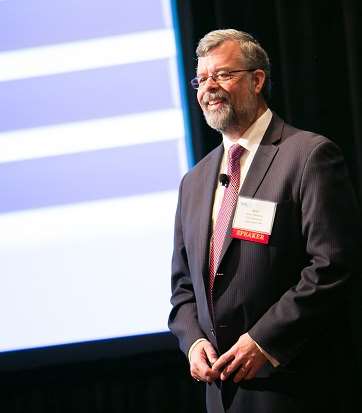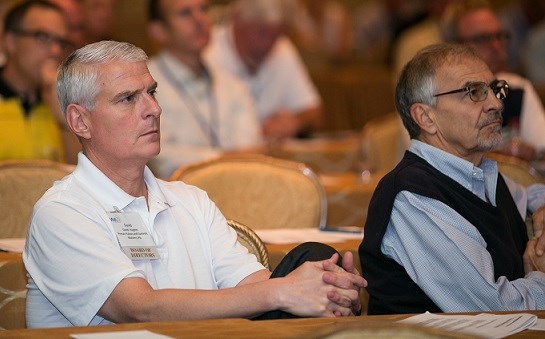VMA Annual Meeting Speakers Deliver Insights on Growth
While there was indeed a great deal of celebration surrounding the 75th Anniversary Annual Meeting of the Valve Manufacturers Association, the nearly 200 attendees were also there to do business.
#VMAnews
Profitable Top-line Growth
James D. Hlavacek is chairman and CEO of The Corporate Development Institute, Inc. In his presentation, he gained the attention of the crowd with the results of a VMA member telephone needs. Hlavacek had asked the respondents to think of one question ahead of the one-hour teleconference he had conducted with each: “What are the challenges you are facing that are keeping you from profitable top-line growth?”
He posed the question to a cross section of members including large, medium and smaller-sized companies. The respondents reflect the membership generally, covering a wide product range, some public, some private and others with private equity ownership. By analyzing the content of the responses, Hlavacek identified six common challenges, and, he said, “Any one of them could cause a VMA member to lose sleep.” They were identified as:
- Globalization
- Users want more performance, safety and value—but they don’t want to pay for it
- Businesses are becoming more technical, but customers are smarter—they want solutions not just products
- Rapidly changing product and process technology
- New requirements, materials and solutions
- More industry and government regulations—and currency fluctuations
Hlavacek identified the transformation every company must make to meet what he called the 10 realities of today’s valve market, and stressed the importance of meeting the challenges raised by each one of them.
The Ten Realities
- Regional and global customers are smarter and more demanding of product performance, cost of ownership and better service. But they are not willing to pay more for it, no matter how profitable they are.
- Cost of producing any product must trend downward. Over the long term it is essential to be a lower cost supplier or profit margins will erode.
- Advancing technology is shortening product and process life cycles: This means an increased risk of payback on the product development, and investment in automation simply to keep pace.
- Complacency with existing products and services: When customers’ changing unmet product or service needs are met with no urgency, you will lose business. “It’s very hard to obsolete your existing products,” said Hlavacek. “We tend not to do that. Software companies have to, and I think we’re going to do that more and more.”
- Lack of focus in R&D and sales: It is essential to target narrow market applications to focus product development, application engineers and salespeople with the right skills, training and incentives to protect and grow market positions.
- Market maturity is a mind-set: Most so-called “mature markets” and commodity products can be revived with demonstrably better new products and/or services. Product and process technological change doesn’t stop in slow growth markets; in fact, it intensifies.
- Compensation drives behavior: “Show me how managers are paid, and I’ll show you how they behave,” he said. “Are they paid for profitable top-line growth or primarily for the bottom line?”
- Successful long-term industrial companies learn about unmet needs in the entire value chain: Hlavacek asked, “Do you regularly elicit ideas directly from all members of the value chain?” He was glad to see that VMA’s publication addresses primarily the end user.
- Commercial and technical people must be trained on how to conduct in-depth technical interviews with OEMs, distributors, system integrators, end-users and other lead members in the value chain.
- Successful long-term companies are learning organizations. Knowledgeable employees who work smarter and safer may be your only sustainable advantage. Are your training funds more vulnerable than a trade show budget?
Hlavacek cited John Deere as an example of one of the best companies in the world. It has replaced International Harvester as the leader in its sector through mostly organic growth. The company has licensed or acquired small new technology for agriculture and construction business with a dual emphasis on product and process innovation. “Deere’s large equipment has more computing power than the first space shuttle!” he said. But the CEO of John Deere has said their two greatest competitive advantages are to continually learn faster than the competition and to continually improve a great dealer partnership network. That’s where service comes in.
What John Deere is demonstrating is what Hlavacek called “outside-in” thinking, where the company looks at customers and competition. It looks at things that are new or different or better. These companies tend to be leaders, as opposed to “inside-out” companies that view their markets too broadly, classifying them by product types and sizes rather than by user requirements, applications and emerging an unmet needs.
In “inside-out” companies, their actions and thinking tend to be dominated by existing product and process features that are blindly assumed to provide an unquestionable competitive advantage. Most are not intimate enough with their customers across the value chain to tailor a product/service package that provides greater value. Bottom line, many are just too inward looking, so they become complacent, arrogant, bureaucratic and believe their own propaganda.
Hlavacek mentioned Sears Roebuck as a prime example. “What happened?” he asked. “They took a 30-year nap!” He also likened bureaucracy to crab grass. It is the kiss of death when it comes to growth.
On the other hand, an “outside-in” company recognizes that being “intimate” with your customers is the key. Managers say, “I want to learn from the progressive users. I can learn much more from two to three progressive customers than more average (comfortable) customers.” It is vital to have technical teams shadow and travel with end users to really understand what they need.
Hlavacek closed off his summary of the 10 steps in the industrial value creation process by saying, “Bottom line, you’re either growing or you’re not.”
As for Growth in the Economy…
That said, however, Beaulieu reminded the audience that everything we do is going to be impacted because the banks, and in particular the Fed, are creating an inflationary pressure they believe they can control. And when that spirals out of control, the way to get it down is an economic contraction. “That’s what will happen in 2019,” he said, warning of a recession he sees coming in that year. Beaulieu also warned that the Affordable Health Care Act along with tighter credit will cause a minor contraction in 2014, but advised companies who want to survive and grow to invest in themselves now.
Hire the good people you really need now, and get into long-term borrowing contracts to prepare for inflationary rates. He also advised companies to get automated wherever possible. “Keep the head count down and tie compensation programs to performance—unlike baseball!” he joked. Beaulieu also stressed it is essential that companies engage the generation behind us, although he recognized that it’s not an easy task.
Beaulieu also referred to the “shale gale,” saying that it has contributed to the U.S. now being the world’s largest producer of oil. “The amount of wealth in this country is astounding,” he said. The trick, of course, is figuring out how to leverage that wealth against the economic pressures of an aging population.
With powerful speakers and an enthusiastic, celebratory crowd, VMA’s 2013, 75th Annual Meeting was the perfect example of how forward-thinking people can grow from a tiny group of 10 valve manufacturers to a powerful association of industry professionals.
Kate Kunkel is senior editor for VALVE Magazine. Reach her at kkunkel@vma.org. Judy Tibbs is editor in chief of VALVE Magazine. Reach her at jtibbs@vma.org.
RELATED CONTENT
-
An Interview With ... Matt Thiel
Matt Thiel, president of AUMA Actuators, was named chairman at VMA’s 2022 annual meeting.
-
Inspection and Maintenance Can Alleviate Supply Chain Woes
As industrial companies confront the challenges posed by global supply chain constraints, extra attention should be paid to maintenance as a strategy for minimizing the need for new equipment and components.
-
New API Standard for Globe Valves
While the American Petroleum Institute (API) and other organizations published a variety of valve standards covering gate, ball, check, butterfly and plug valves for decades, the first for globe valves came out in 2013.












 Unloading large gate valve.jpg;maxWidth=214)